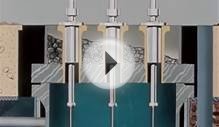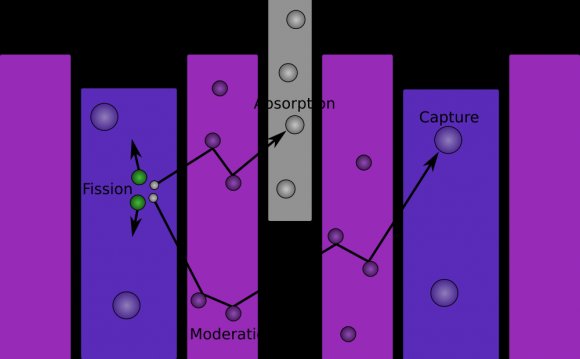
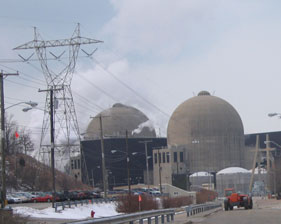
What is a nuclear reactor?
A nuclear reactor is a system that contains and controls sustained nuclear chain reactions. Reactors are used for generating electricity, moving aircraft carriers and submarines, producing medical isotopes for imaging and cancer treatment, and for conducting research.
Fuel, made up of heavy atoms that split when they absorb neutrons, is placed into the reactor vessel (basically a large tank) along with a small neutron source. The neutrons start a chain reaction where each atom that splits releases more neutrons that cause other atoms to split. Each time an atom splits, it releases large amounts of energy in the form of heat. The heat is carried out of the reactor by coolant, which is most commonly just plain water. The coolant heats up and goes off to a turbine to spin a generator or drive shaft. Nuclear reactors are just exotic heat sources.
Animated reactor system
The image above (reproduced from the NRC) shows a nuclear reactor heating up water and spinning a generator to produce electricity. It captures the essence of the system well. The water coming into the condenser and then going right back out would be water from a river, lake, or ocean. It goes out the cooling towers. As you can see, this water does not go near the radioactivity, which is in the reactor vessel.
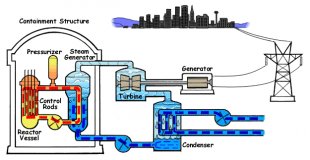 Fuel pins
Fuel pins
The smallest unit of the reactor is the fuel pin. These are typically uranium-oxide (UO2), but can take on other forms, including thorium-bearing material. They are often surrounded by a metal tube (called the cladding) to keep fission products from escaping into the coolant.
Fuel assembly
Fuel assemblies are bundles of fuel pins. Fuel is put in and taken out of the reactor in assemblies. The assemblies have some structural material to keep the pins close but not touching, so that there’s room for coolant.
Full core
This is a full core, made up of several hundred assemblies. Some assemblies are control assemblies. Various fuel assemblies around the core have different fuel in them. They vary in enrichment and age, among other parameters. The assemblies may also vary with height, with different enrichments at the top of the core from those at the bottom.
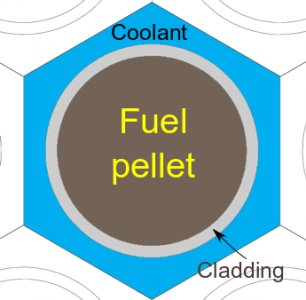 Types of Reactors
Types of Reactors
There are many different kinds of nuclear fuel forms and cooling materials can be used in a nuclear reactor. As a result, there are thousands of different possible nuclear reactor designs. Here, we discuss a few of the designs that have been built before, but don’t limit your imagination; many other reactor designs are possible. Dream up your own!
Pressurized Water Reactor
The most common type of reactor. The PWR uses regular old water as a coolant. The primary cooling water is kept at very high pressure so it does not boil. It goes through a heat exchanger, transferring heat to a secondary coolant loop, which then spins the turbine. These use oxide fuel pellets stacked in zirconium tubes. They could possibly burn thorium or plutonium fuel as well.
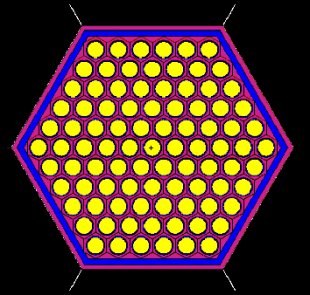 Pros:
Pros:
- Very much operating experience has been accumulated and the designs and procedures have been largely optimized.
Cons:
- Pressurized coolant escapes rapidly if a pipe breaks, necessitating lots of back-up cooling systems.
Boiling Water Reactor
Second most common, the BWR is similar to the PWR in many ways. However, they only have one coolant loop. The hot nuclear fuel boils water as it goes out the top of the reactor, where the steam heads over to the turbine to spin it.
Pros:
- Simpler plumbing reduces costs
- Power levels can be increased simply by speeding up the jet pumps, giving less boiled water and more moderation. Thus, load-following is simple and easy.
- With liquid and gaseous water in the system, many weird transients are possible, making safety analysis difficult
- Primary coolant is in direct contact with turbines, so if a fuel rod had a leak, radioactive material could be placed on the turbine. This complicates maintenance as the staff must be dressed for radioactive environments.
- Can’t breed new fuel — susceptible to "uranium shortage"
- Does not typically perform well in station blackout events, as in Fukushima.
Canada Deuterium-Uranium Reactors (CANDU)
CANDUs are a Canadian design found in Canada and around the world. They contain heavy water, where the Hydrogen in H2O has an extra neutron (making it Deuterium instead of Hydrogen). Deuterium absorbs many fewer neutrons than Hydrogen, and CANDUs can operate using only natural uranium instead of enriched.
- Can be refueled while operating, keeping capacity factors high (as long as the fuel handling machines don’t break).
- Are very flexible, and can use any type of fuel.
YOU MIGHT ALSO LIKE


